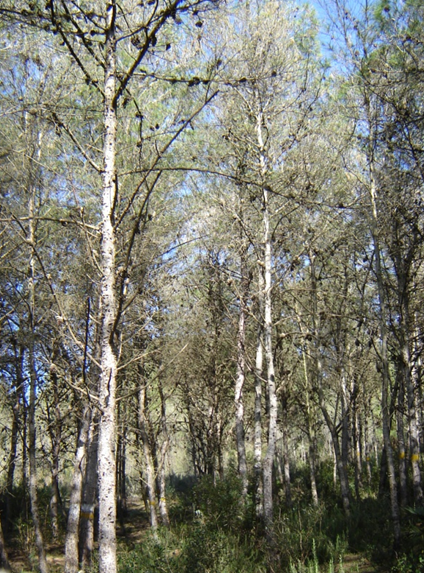
Objective:
Aleppo pine is one of the dominant forest species in Tunisia, favoured by its great regeneration capacity, plasticity, climatic stress tolerance, and multiple products: wood, edible seeds, vegetable seed oil, essential oils from leaves. For these reasons it has been used massively as for reforestation.
But the wide geographical distribution of the species might imply variation in adaptive and productive traits. The use of genetic material well adapted to the environment and better performing allows for valorization of the resource and offers a guarantee of success for new reforestation. In this context, selection of the best provenances from comparative trials is an interesting research issue.
Context:
In order to explore the geographic variability of Aleppo pine, comparative multi-site plantations were used. In the present study, the emphasis was on exploiting the oldest experiments dating from the 1960s. The initial experimental network implemented by forestry research included 7 devices installed in ecologically contrasting sites. Actually, only four can be exploited, namely: Souiniet (humid), Korbous (sub sub humid), Jbel Abderrahmane (sub sub humid) and Henchir Naame (semi-arid). These trials regroup 40 provenances, including 29 from Tunisia; the other provenances are distributed unevenly between Morocco, Italy and Palestine.
Contacts:
Further information:
Khouja M.L., 1993 - Influence de l’enlèvement des cônes sur la croissance en hauteur du pin d’Alep. Note de recherches de l’Institut National de Recherches Forestières de Tunisie : 15 p.
Khouja, ML., (1997). Variabilité géographique du pin d’Alep en Tunisie perspectives d'amélioration de la productivité et de la qualité physique du bois. Thèse en vue d’obtention du diplôme de doctorat en sciences agronomiques et Ingénierie biologique. Université Catholique de Louvain-Belgique, 181p.
Khouja M. L., Sghaîer T., 2000 – Variabilité intraspécifique du pin d’Alep (Pinus halepensis) et possibilités de sélection à un stade précoce. Annales de l’INRGREF, 4, p183-198.
Khouja M. L., Sghaîer T., Nouri M. et André P., 2000 – Variabilité morphométrique du pin d’Alep (Pinus halepensis) et perspectives d’amélioration génétique. Annales de l’INRGREF,
Khouja M. L, 2001a - Variabilité de la densité du bois estimée par pénétrométrie (pilodyn) chez le pin d’Alep. Annales de la recherche forestière au Maroc. T. 34, pp. 48-64
Khouja M. L., 2001b - Amélioration génétique : inventaire et bilan des recherches entreprises en Tunisie. Annales de l’INRGREF n°5 (numéro spécial). pp. 1 – 44.
Khouja ML., Abdallah H., Sghaier T., Nouri M. et Akrimi N., 2003 - Résultats des essais d’acclimatation de quelques espèces de pin au nord de la Tunisie. Annales de l’INRGREF, 6, p1-15.
Khouja M.L., Boughecha Belkhodja K. et Zid E., 2006 - Germination de provenances de pin d’Alep (Pinus halepensis Mill.) en condition de stress osmotique, 2006. Annales de l’INRGREF, 9, Numéro spécial, p1-17.